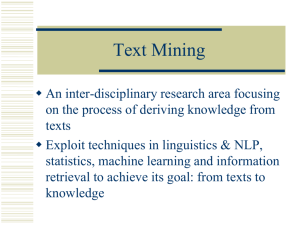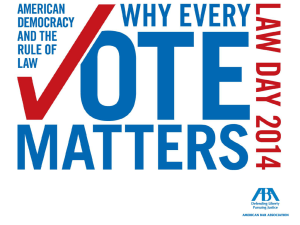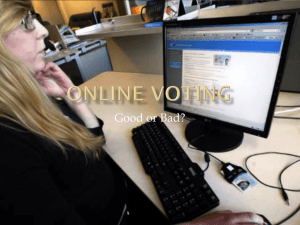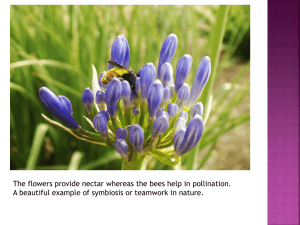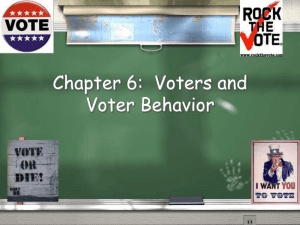Machine Learning Techniques for Automatic Ontology Extraction
advertisement
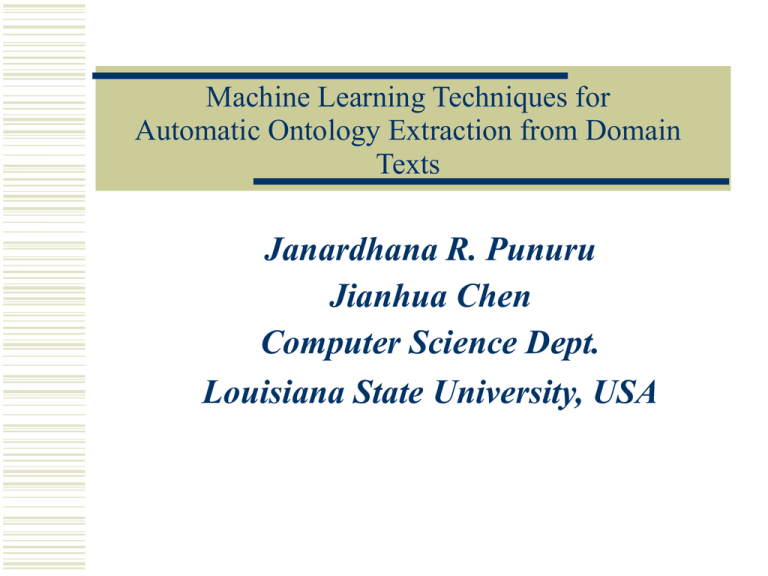
Machine Learning Techniques for
Automatic Ontology Extraction from Domain
Texts
Janardhana R. Punuru
Jianhua Chen
Computer Science Dept.
Louisiana State University, USA
Presentation Outline
Introduction
Concept extraction
Taxonomical relation learning
Non-taxonomical relation learning
Conclusions and Future Works
Introduction
Ontology
An ontology OL of a domain D is a specification of
a conceptualisation of D, or simply, a data model
describing D. An OL typically consists of:
A list of concepts important for domain D
A list of attributes describing the concepts
A list of taxonomical (hierarchical) relationships
among these concepts
A list of (non-hierarchical) semantical
relationships among these concepts
Sample (partial) Ontology – Electronic Voting
Domain
Concepts: person, voter, worker, poll watcher,
location, county, precinct, vote, ballot, machine, voting
machine, manufacturer, etc.
Attributes: name of person, model of machine, etc.
Taxonomical relations:
Voter is a person; precinct is a location; voting
machine is a machine, etc.
Non-hierarchical relations:
Voter cast ballot; voter trust machine; county adopt
machine; equipment miscount ballot, etc.
Sample (partial) Ontology – Electronic Voting
Domain
Applications of Ontologies
Knowledge representation and knowledge management
systems
Intelligent query-answering systems
Information retrieval and extraction
Semantic Web
Web pages annotated with ontologies
User queries for Web pages analysed at knowledge
level and answered by inferencing on ontological
knowledge
Task: automatic ontology
extraction from domain texts
texts
Ontology
extraction
ontology
Challenges in Text Processing
Unstructured texts
Ambiguity in English text
Multiple senses of a word
Multiple parts of speech – e.g., “like” can occur in 8 PoS:
Verb: “Fruit flies like banana”
Noun: “We may not see its like again”
Adjective: “People of like tastes agree”
Adverb: “The rate is more like 12 percent”
Preposition: “Time flies like an arrow”
etc
Lack of closed domain of lexical categories
Noisy texts
Requirement of very large training text sets
Lack of standards in text processing
Challenges in Knowledge
Acquisition from Texts
Lack of standards in knowledge representation
Lack of fully automatic techniques for KA
Lack of techniques for coverage of whole texts
Existing techniques typically consider word
frequencies, co-occurrence statistics, syntactic
patterns, and ignore other useful information from
the texts
Full-fledged natural language understanding is still
computationally infeasible for large text collections
Our Approach
Our Approach
Concept Extraction: Existing Methods
Frequency-based methods
Text-to-Onto [Maedche & Volz 2001]
Use syntactic patterns and extract concepts
matching the patterns
[Paice, Jones 1993]
Use WordNet
[Gelfand et. Al. 2004] start from a base word list,
for each w in the list, add the hypernyms and
hyponyms in WordNet to the list
Concept Extraction: Our Approach
Parts of Speech tagging and NP chunking
Morphological processing – word stemming,
converting words to root form
stopword removal
Focus on top % freq. NP
Focus on NP with fewer number of WordNet
senses
Concept Extraction: WordNet Sense Count
Approach
Background: WordNet
General lexical knowledge base
Contains ~ 150,000 words (noun, verb, adj, adv)
A word can have multiple senses: “plant” as a noun has 4
senses
Each concept (under each sense and PoS) is represented
by a set of synonyms (a syn-set).
Semantic relations such as hypernym/antonym/meronym
of a syn-set are represented
WordNet - Princeton University Cognitive Science
Laboratory
Background: Electronic Voting Domain
15 documents from New York Times
(www.nytimes.com)
Contains more than 10,000 words
Pre-processing produced 768 distinct noun phrases
(concepts)
329 relevant to electronic voting
439 irrelevant
Background: Text Processing
Many local election officials and voting machine companies are fighting paper trails, in part
because they will create more work and will raise difficult questions if the paper and electronic
tallies do not match.
●
●
●
●
POS Tagging: Many/JJ local/JJ election/NN officials/NNS and/CC voting/NN machine/NN
companies/NNS are/VBP fighting/VBG paper/NN trails,/NN in/IN part/NN because/IN they/PRP
will/MD create/VB more/JJR work/NN and/CC will/MD raise/VB difficult/JJ questions/NNS if/IN
the/DT paper/NN and/CC electronic/JJ tallies/NNS do/VBP not/RB match./JJ
NP Chuking: [ Many/JJ local/JJ election/NN officials/NNS ] and/CC [ voting/NN machine/NN
companies/NNS ] are/VBP fighting/VBG [ paper/NN trails,/NN ] in/IN [ part/NN ] because/IN [
they/PRP ] will/MD create/VB [ more/JJR work/NN ] and/CC will/MD raise/VB [ difficult/JJ
questions/NNS ] if/IN [ the/DT paper/NN ] and/CC [ electronic/JJ tallies/NNS ] do/VBP not/RB [
match./JJ]
Stopword Elimination: local/JJ election/NN officials/NNS, voting/NN machine/NN
companies/NNS , paper/NN trails,/NN, part/NN, work/NN, difficult/JJ questions/NNS,
paper/NN, electronic/JJ tallies/NNS, match./JJ
Morphological Analysis: local election official, voting machine company, paper trail, part, work,
difficult question, paper, electronic tally
WNSCA + {PE, POP}
Take top n% of NP, and select only those with less than 4
senses in WordNet ==> obtain T, a set of noun phrases
Make a base list L of words from T
PE: add to T, any noun phrase np from NP, if the headword (ending word) in np is in L
POP: add to T, any noun phrase np from NP, if some
word in np is in L
Evaluation: Precision and Recall
S
T
Precision:
n
Recall:
|S T |
|S |
|S T |
|T |
precision
Evaluations on the E-voting Domain
100
90
80
70
60
50
40
30
20
10
0
Raw Freq
WNSCA
W +PE
W + POP
Top
10%
Top
20%
Top
50%
Top
75%
frequency threshold
Evaluations on the E-voting Domain
90
80
70
recall
60
Raw Freq
WNSCA
W +PE
W + POP
50
40
30
20
10
0
Top
10%
Top
25%
Top
50%
Top
75%
frequency threshold
TF*IDF Measure
TF*IDF: Term Frequency Inverted Document Frequency
| D|
TF * IDF (t ij ) f ij* Log
| Di |
|D|: total number of documents
|Di|: total number of documents containing term ti
TF*IDF(tij): TF*IDF measure for term ti in document dj
fij: frequency of term ti in document dj
Comparison with the tf.idf method
tf.idf
WNSCA
W+PE
W+POP
325
300
275
250
225
200
175
150
125
100
75
50
25
0
Retrieved
R & Rel
Precision
Recall
F-measure
Evaluations on the TNM Domain
TNM Corpus: 270 texts in the TIPSTER Vol. 1 data from
NIST: 3 years (87, 88, 89) news articles from Wall Street
Journal, in the category of “Tender offers, Mergers and
Acquisitions”
30 MB in size
183, 348 concepts extracted - only used the top 10%
frequent ones in the experiments - manually label the
18,334 concepts: only 3,388 concepts are relevant
Use the top 1% frequent concepts as the initial cut
Evaluations on the TNM Domain
90
80
70
60
tf*idf
WNSCA
W+10%PE
W+10%POP
50
40
30
20
10
0
Pre.
Recall
f-measure
Taxonomy Extraction: Existing Methods
A taxonomy: an “is-A” hierarchy on concepts
Existing approaches:
Hierarchical clustering: Text-To-Onto
but this needs users to manually label the internal nodes
Use lexico-syntactic patterns: [Hearst 1992, Iwanska 1999]
“musical instruments, such as piano and violin … “
Use seed concepts and semantic variants: [Morin &
Jacqumin 2003] “An apple is a fruit” “Apple juice is
fruit juice”
Taxonomy Extraction: Our Method
3 techniques for taxonomy extraction
Compound term heuristic: “voting machine” is a
machine
WordNet-based method – needs word sense
disambiguation (WSD)
Supervised learning (Naive-Bayes) for semantic
class labeling (SCL) of concepts
Semantic Class Labeling of
Concepts
Given: semantic classes T ={T1, ..., Tk } and
concepts C = { C1, ..., Cn}
Find: a labeling L: C --> T, namely, L(c)
identifies the semantic class of concept c for
each c in C.
For example, C = {voter, poll worker, voting
machine} and T = {person, location, artifacts}
SCL
Naïve Bayes Learning for SCL
Four attributes are used to describe any
concept
1. The last 2 characters of the concept
2. The head word of the concept
3. The pronoun following the concept
4. The preposition proceeding the concept
Naïve Bayes Learning for SCL
Naïve Bayes Classifier:
Given an instance x = <a1, ..., an>, and
a set of classes Y = {y1, ..., yk}
n
NB(x) =
arg max Pr( y) Pr( aj | y)
y Y
j 1
Evaluations
On E-voting domain:
622 instances, 6-fold cross-validation: 93.6% prediction
accuracy
Larger experiment: from WordNet
2326 in the person category
447 in the artifacts category
196 in the location category
223 in the action category
2624 instances from the Reuters data, 6-fold cross-val.
produced 91.0% accuracy
Reuters data: 21578 Reuters news wire articles in 1987
Attribute Analysis for SCL
Non-taxonomical relation learning
We focus on learning non-hierarchical relations of form
<Ci, R, Cj>
Here R is a non-hierarchical relation, and Ci, Cj are
concepts
Example relations: < voter, cast, ballot>
<official, tell, voter>
<machine, record, ballot>
Related Works
Non-hierarchical relation learning is relatively less
tackled
Several works on this problem make restrictive
assumptions:
Define a fixed set of concepts, then look for relations
among these concepts
Define a fixed set of non-hierarchical relations, then
look for concept pairs satisfying these relations
Syntactical structure of the form (subject, verb, object)
is often used
Ciaramita et al(2005):
Use a pre-defined set of relations
Extract concept pairs satisfying such a relation
Use chi-square test to verify the statistical significance
Experimented with the Molecular Biology domain texts
Schutz and Buitelaar (2004):
Also use a pre-defined set of relations
Build triples from concept pairs and relations
Experimented with the football domain texts
Kavalec et al(2004)
No pre-defined set of relations
Use the following AE measure to estimate the
strength of the triple:
AE ((C1 C2)|V )
P((C1 C2)|V )
P(C1|V ) P(C2|V )
(1)
Experimented with the tourism domain texts
We have also implemented the AE measure for the
purpose of performance comparisons
Our Method
The the framework of our method
Extracting concepts and concept pairs
Domain concepts C are extracted using
WNSCA + PE/POP
Concept pairs are obtained in two ways:
RCL: Consider pairs (Ci, Cj), both from C, and
occurring together in at least one setence
SVO: Consider pairs (Ci, Cj), both from C, and
occurring as subject and object in a sentence
Both use log-likelihood ratio to choose good pairs
Verb extraction using VF*ICF Measure
Focus on verbs specific to the domain
Filter out overly general ones such as “do”, “is”
| C|
VF * ICF (V ) (1 Log (VF ( V )) Log
CF (V )
|C|: total number of concepts
VF(V): number of counts of V in all domain texts
CF(V): number of concepts in the same sentence as V
(2)
Sample top verbs from the
electronic voting domain
Verb V
produce
check
ensure
purge
create
include
say
restore
certify
pass
VF*ICF(V)
25.010
24.674
23.971
23.863
23.160
23.160
23.151
23.088
23.047
23.047
Relation label assignment by
Log-likelihood ratio measure
Candidate triples: (C1, V, C2)
(C1, C2) is a candidate concept pair (by log-likelihood measure)
V is a candidate verb (by VF*ICF measure)
The triple occurs in a sentence
Question: Is the co-occurrence of V and the pair (C1, C2)
accidental?
Consider the following two hypotheses:
H1: P(V |(C1 C2)) P(V | (C1 C2))
H 2: P(V |(C1 C2)) P(V | (C1 C2))
S(C1, C2): set of sentences containing both C1, C2
S(V): set of sentences containing V
n
|
S
(
C
,
C
)
| n
|
S
(
V
)
| n
|
S
(
C
,
C
)
S
(
V
)
|
C
1
2
V
C
V
1
2
N
n
|C |
|S(V ) S(C, C )|
i
i 1j , k 1
j
k
Log-likelihood ratio:
Log Log
L( H1)
L( H2)
L( H1) b(ncv;nc, p)b(n v ncv; N nc, p)
L( H 2) b(ncv;nc, p1)b(nv ncv; N nc, p2)
nV
p
N
p1
nCV
nC
p2
nV nCV
N nC
n k
b( k ; n, p ) p (1 p) ( n k )
k
For concept pair (C1, C2), select V with highest value for
2Log
Experiments on the E-voting Domain
Recap: E-voting domain
15 articles from New York Times
More than 10,000 distinct English words
164 relevant concepts were used in the experiments
For VF*ICF validation:
First removed stop words
Then apply VF*ICF measure to sort the verbs
Take the top 20% of the sorted list as relevant verbs
Achieved 57% precision with the top 20%
Experiments -Continued
Criteria for evaluating a triple (C1, V, C2)
C1 and C2 are related non-hierarchically
V is a semantic label for either C1 C2 or
C2 C1
V is a semantic label for C1 C2 but not
for C2 C1
Experiments -Continued
yiuy787878uyuiuuuiuiuiiii
Table II Example concept pairs
Concept pairs (C1, C2)
(election,
official)
(company,
voting machine)
(ballot,
voter)
(manufacturer,
voting machine)
(polling place,
worker)
(polling place,
precinct)
(poll,
security)
Experiments –RCL method
Table III RCL method example triples
CConcept C1
Label V
Concept C2
machine
ballot
paper
polling place
polling place
election
ballot
manufacturer
produce
cast
produce
Show up
turn
insist
include
install
paper
voter
voting
voter
voter
official
paper
voting machine
Experiments –SVO method
Table IV SVO method example triples
Concept C1
machine
voter
voter
official
voter
worker
county
company
machine
Label V
Concept C2
produce
cast
record
tell
trust
direct
adopt
provide
record
paper
ballot
vote
voter
machine
voter
machine
machine
ballot
Comparisons
Table V Accuracy comparisons
Method
(C1, C2)
(C1, V, C2)
(C1 V C2)
AE
89.00%
6.00%
4.00%
RCL
81.58%
30.36%
9.82%
SVO
89.47%
68.42%
68.42%
Conclusions and Future Work
Presented techniques for automatic ontology extraction from
texts
Combination of knowledge-base (WordNet), machine
learning, information retrieval, syntactic patterns and
heuristics
For concept extraction, WNSCA gives good precision and
WNSCA + POP gives good recall
For taxonomy extraction, SCL and compound word heuristics
are quite useful. The naïve Bayes classifier works well for
SCL
For non-taxonomy extraction, SVO method has good
accuracy, but
Require using syntactical parsing
Conclusions and Future Work
Both WNSCA and SVO are unsupervised method whereas
SCL is a supervised one - what about un-supervised SCL?
The quality of extracted concepts heavily influences
subsequent ontology extraction tasks
Better word sense disambiguation method would help to
produce better taxonomy extraction results using WordNet
Consideration of other syntactic/semantic information may be
needed to further improve non-taxonomical relation extraction
Incorporate other knowledge
More experiments with larger text collections
Prepositional phrases
Use WordNet
Thanks!
I am grateful to the CSC Department of UNC
Charlotte for hosting my visit.
Special thanks to Dr. Zbigniew Ras for his
inspirations and continuous support over many
years.
